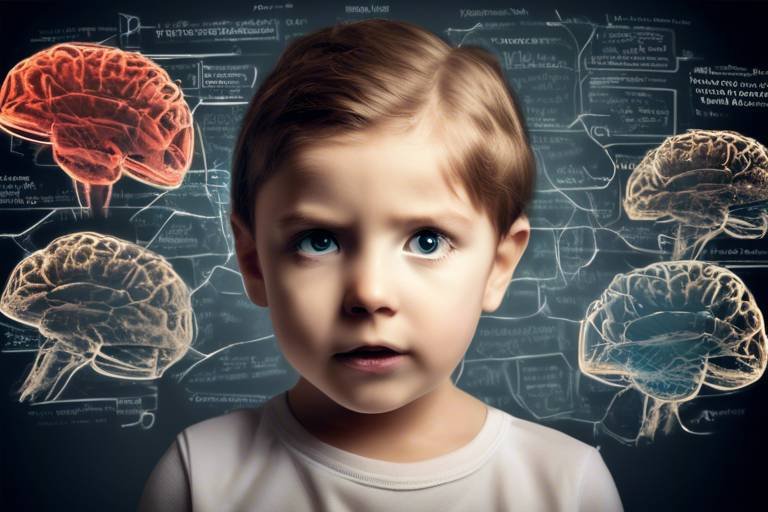Recent Advances in Understanding Psychological Resilience
In recent years, the field of psychology has made significant strides in understanding psychological resilience, a vital component of mental health that enables individuals to bounce back from life's challenges. Resilience is not just about enduring hardship; it's about thriving despite adversity. This evolving understanding is reshaping how we approach mental health interventions, education, and therapy. Imagine resilience as a sturdy tree that bends in the wind but doesn't break, adapting to the storms of life while continuing to grow. The latest research sheds light on various factors that contribute to this remarkable ability, offering insights that can be applied across different domains.
One of the most exciting developments in this area is the recognition that resilience is not solely an innate trait but rather a dynamic process influenced by a myriad of factors. These include personality traits, social support systems, and environmental contexts. For instance, individuals with a strong sense of community or supportive relationships often exhibit higher resilience. This understanding empowers us to foster resilience not just at the individual level but also within communities, creating a ripple effect that enhances overall mental well-being.
Moreover, recent studies have delved into the genetic and neurobiological underpinnings of resilience. It's fascinating to consider that our DNA might play a role in how we respond to stress. Research suggests that certain genetic markers are associated with resilience, which opens up potential pathways for tailored interventions that address specific needs. Coupled with this, the exploration of epigenetics—how our environment can influence gene expression—provides a compelling narrative. Life experiences, such as trauma or nurturing environments, can shape our resilience, indicating that there’s hope for everyone.
As we unravel the complexities of resilience, we also recognize the critical role of social support. Relationships matter; they are the bedrock upon which resilience is built. A supportive friend, a caring teacher, or a loving family can make all the difference in how someone copes with adversity. Understanding these dynamics allows us to create programs and interventions that strengthen social bonds, ultimately enhancing resilience in individuals and communities alike.
In summary, the advances in understanding psychological resilience are not just academic; they have real-world implications that can transform lives. By integrating insights from genetics, social science, and community dynamics, we can develop comprehensive strategies that empower individuals to thrive. As we continue to explore this fascinating field, one thing remains clear: resilience is not merely a trait but a skill that can be nurtured and developed, much like a muscle that grows stronger with use.
- What is psychological resilience?
Psychological resilience is the ability to adapt and recover from stress and adversity, enabling individuals to thrive despite challenges. - Can resilience be developed?
Yes, resilience can be nurtured through supportive relationships, positive experiences, and targeted interventions. - What role does social support play in resilience?
Social support provides emotional and practical assistance, which enhances an individual's ability to cope with stress. - Are there genetic factors associated with resilience?
Research suggests that certain genetic markers may influence an individual's resilience, although environmental factors also play a significant role.

The Concept of Psychological Resilience
Psychological resilience is more than just a buzzword; it’s a vital concept that embodies our ability to bounce back from life's challenges. Imagine a rubber band—when you stretch it, it may seem like it’s at its breaking point, but once you release it, it returns to its original shape. This metaphor perfectly illustrates what resilience is all about: the capacity to adapt and recover, even when faced with significant stress or adversity. In today's fast-paced world, understanding this concept is crucial for developing effective interventions that enhance mental well-being and promote healthy coping mechanisms.
At its core, resilience involves a combination of mental processes and emotional responses that allow individuals to navigate through tough times. It’s not just about enduring hardships; it’s about thriving despite them. Research indicates that resilient individuals possess certain traits, such as optimism, emotional regulation, and a strong sense of self-efficacy. These traits enable them to view challenges as opportunities for growth rather than insurmountable obstacles.
Moreover, resilience is not a static trait; it can be developed over time through experiences and intentional practices. For instance, engaging in mindfulness, maintaining strong social connections, and fostering a positive mindset are all strategies that can enhance one’s resilience. Just like building muscle, the more we work on our resilience, the stronger it becomes. This adaptability is crucial not only for personal mental health but also for fostering a supportive community.
To further explore the concept of resilience, let’s consider some essential elements that contribute to its development:
- Emotional Awareness: Recognizing and understanding one’s emotions is fundamental in managing stress effectively.
- Social Connections: Building a network of supportive relationships can provide the necessary encouragement during tough times.
- Problem-Solving Skills: The ability to approach challenges with a strategic mindset can lead to effective solutions.
- Self-Care Practices: Engaging in activities that promote physical and mental health is crucial for maintaining resilience.
In summary, psychological resilience is an essential attribute that enables individuals to withstand the storms of life. By understanding its components and actively working to cultivate resilience, we can not only improve our own mental health but also contribute positively to the well-being of those around us. As we delve deeper into the factors influencing resilience in the following sections, it becomes clear that this concept is not just about individual strength; it’s about community, support, and shared experiences.

Factors Influencing Resilience
Resilience is not a one-size-fits-all trait; it’s a complex interplay of various factors that shape an individual's ability to bounce back from life’s challenges. Think of resilience as a sturdy tree in a storm—its strength comes from a combination of deep roots, a flexible trunk, and a supportive environment. In this section, we’ll explore the myriad of elements that contribute to resilience, helping us understand how we can cultivate it in ourselves and others.
First and foremost, personality traits play a crucial role in determining how resilient a person can be. Traits such as optimism, self-efficacy, and emotional regulation can significantly enhance one’s ability to cope with stress. For example, individuals who possess a strong sense of self-efficacy—believing they can influence their circumstances—are more likely to tackle challenges head-on rather than retreating in fear. It’s like having a mental toolkit ready to repair the damage caused by life’s adversities.
Another vital factor is social support. The relationships we build with family, friends, and communities can act as a buffer against stress. Imagine facing a difficult situation like a job loss; having a network of supportive people can make all the difference. Studies show that those who have strong social ties are more likely to exhibit resilience. They can lean on others for emotional support, advice, or even just a listening ear, which can lighten the emotional load significantly.
Environmental influences also play a pivotal role in shaping resilience. Factors such as socioeconomic status, access to education, and community resources can either hinder or promote resilience. For instance, children raised in nurturing environments with access to quality education and extracurricular activities often develop stronger coping mechanisms. In contrast, those in high-stress environments may struggle to find their footing. This is why creating supportive environments is essential, particularly for vulnerable populations.
To summarize, the factors influencing resilience can be categorized into three main areas:
- Personality Traits: Optimism, self-efficacy, and emotional regulation.
- Social Support: Relationships with family, friends, and community networks.
- Environmental Influences: Socioeconomic status, education, and community resources.
Understanding these factors not only helps in identifying individuals who may need support but also guides the development of targeted interventions aimed at enhancing resilience. Whether through therapy, community programs, or educational initiatives, fostering resilience can lead to healthier coping strategies and improved mental well-being.
What is psychological resilience?
Psychological resilience is the ability to adapt and recover from stress and adversity. It involves bouncing back from difficult experiences and maintaining mental well-being.
What factors contribute to resilience?
Several factors contribute to resilience, including personality traits (like optimism), social support from friends and family, and environmental influences such as socioeconomic status and access to education.
Can resilience be developed?
Yes, resilience can be developed through various means, including therapy, supportive relationships, and community programs that focus on building coping skills and emotional strength.
How does social support influence resilience?
Social support provides emotional comfort, practical assistance, and a sense of belonging, all of which can help individuals cope with stress and recover from setbacks more effectively.

Role of Genetics in Resilience
The role of genetics in psychological resilience is a fascinating and rapidly evolving area of research. As scientists dig deeper into the complexities of human behavior, they are uncovering how our genetic makeup influences our ability to cope with stress and adversity. Imagine resilience as a robust tree that withstands fierce storms; its roots may be deeply intertwined with genetic factors that provide stability and strength. This analogy highlights the significance of understanding the genetic components that contribute to resilience.
Recent studies suggest that specific genes may be linked to resilience, affecting how individuals respond to challenging situations. For example, variations in genes related to neurotransmitter systems, such as serotonin and dopamine, can influence mood regulation and stress response. This means that some people may naturally possess a genetic predisposition that allows them to bounce back from setbacks more effectively than others. However, it's essential to recognize that genetics is only part of the equation; environmental factors and personal experiences also play a crucial role.
Moreover, researchers are exploring the concept of gene-environment interactions, which refers to how environmental factors can influence gene expression, and vice versa. This interplay suggests that while genetics may provide a foundation for resilience, life experiences can either strengthen or weaken that foundation. For instance, a person with a genetic predisposition for resilience might flourish in a supportive environment, while the same individual could struggle if faced with chronic stressors or adversity.
To illustrate this complex relationship, consider the following table that summarizes key genetic factors associated with resilience:
| Genetic Factor | Role in Resilience |
|---|---|
| 5-HTTLPR (Serotonin Transporter Gene) | Affects mood regulation and stress response; variations may influence resilience levels. |
| BDNF (Brain-Derived Neurotrophic Factor) | Supports brain health and adaptability; linked to emotional regulation and coping strategies. |
| COMT (Catechol-O-Methyltransferase) | Influences dopamine metabolism; variations can affect stress resilience and cognitive flexibility. |
Understanding these genetic influences not only sheds light on why some individuals are more resilient than others but also opens the door to targeted interventions. For instance, if we identify specific genetic markers associated with resilience, we can tailor therapeutic approaches to enhance coping strategies in those who may be genetically predisposed to struggle. This personalized approach could lead to more effective mental health treatments and support systems.
In conclusion, while genetics plays a significant role in shaping our resilience, it's essential to remember that it does not act in isolation. The dynamic interplay between our genes and our environment creates a unique tapestry of resilience for each individual. By continuing to explore these genetic underpinnings, we can develop better strategies to foster resilience in those who need it most, ultimately leading to improved mental health outcomes across various populations.

Epigenetics and Resilience
Epigenetics, a fascinating field that studies how environmental factors can influence gene expression without altering the underlying DNA sequence, plays a pivotal role in understanding psychological resilience. This means that our experiences, particularly those involving stress and adversity, can leave a mark on our genes, affecting how we respond to future challenges. Imagine your genes as a musical score; while the notes (DNA) remain the same, the way they are played (gene expression) can vary dramatically based on the conductor (environmental influences).
Recent research has illuminated how epigenetic changes can be triggered by various life experiences, such as trauma, chronic stress, or even positive influences like supportive relationships and nurturing environments. These changes can lead to alterations in brain function and behavior, shaping how resilient a person can be in the face of adversity. For instance, a child who grows up in a supportive environment may have epigenetic modifications that enhance their ability to cope with stress later in life, while another child exposed to chronic stress may develop a different set of epigenetic markers that make them more vulnerable.
Moreover, the implications of epigenetics extend beyond individual experiences. They offer a glimpse into how communities can foster resilience through environmental changes. By creating supportive, enriching environments, we can potentially influence the epigenetic landscape of entire populations, promoting resilience on a broader scale. This underscores the importance of community support systems, educational initiatives, and mental health resources in cultivating resilience.
To illustrate the impact of epigenetics on resilience, consider the following table that summarizes key findings from recent studies:
| Study | Findings | Implications |
|---|---|---|
| Smith et al. (2021) | Identified specific epigenetic markers associated with resilience in individuals who experienced childhood adversity. | Highlights the potential for targeted interventions based on genetic profiles. |
| Jones & Taylor (2022) | Showed that positive family environments can lead to beneficial epigenetic changes. | Supports the need for programs that enhance family support structures. |
| Lee et al. (2023) | Explored the role of community programs in shaping epigenetic factors linked to resilience. | Emphasizes the importance of community resources in building resilience. |
In conclusion, the study of epigenetics not only deepens our understanding of resilience but also opens up exciting avenues for intervention and support. By recognizing that our environment and experiences can influence our genetic expression, we can take proactive steps to foster resilience in ourselves and others, creating a more supportive and resilient society.
- What is epigenetics? Epigenetics refers to the study of changes in gene expression that do not involve alterations to the underlying DNA sequence. It examines how environmental factors can influence these changes.
- How does epigenetics relate to resilience? Epigenetics can affect how individuals respond to stress and adversity, potentially enhancing or diminishing their resilience based on their life experiences and environmental influences.
- Can resilience be taught? Yes, resilience can be fostered through supportive environments, educational programs, and community resources that promote healthy coping mechanisms.

Neurobiology of Resilience
The neurobiology of resilience is a fascinating field that examines how our brains respond to stress and adversity. Imagine your brain as a complex city, with various neighborhoods representing different functions and structures. Each neighborhood plays a unique role in how we cope with challenges. For instance, the prefrontal cortex, often referred to as the brain's control center, is crucial for decision-making and regulating emotions. This area helps us think clearly during stressful situations, which is essential for resilience.
Research has shown that resilient individuals often exhibit enhanced activity in certain brain regions when faced with stress. This heightened activity allows them to process information more effectively and respond to challenges with a greater sense of calm. On the flip side, those who struggle with resilience may experience increased activity in the amygdala, the part of the brain responsible for processing emotions like fear and anxiety. This can lead to a heightened stress response, making it harder to bounce back from difficulties.
One particularly interesting aspect of resilience is the role of neurotransmitters, which are chemical messengers in the brain. For example, serotonin and dopamine are linked to mood regulation and feelings of well-being. Individuals with higher levels of these neurotransmitters often report feeling more positive and capable of handling stress. Thus, fostering an environment that promotes healthy neurotransmitter levels can be a game-changer in developing resilience.
Moreover, the concept of neuroplasticity plays a pivotal role in resilience. Neuroplasticity is the brain's ability to reorganize itself by forming new neural connections throughout life. This means that even if someone has a history of trauma or stress, they can still develop resilience through targeted interventions such as therapy, mindfulness practices, and social support. Think of it as renovating a house; with the right tools and effort, you can create a stronger, more resilient structure that can withstand future storms.
To illustrate the interplay between different brain regions and resilience, consider the following table:
| Brain Region | Function | Role in Resilience |
|---|---|---|
| Prefrontal Cortex | Decision-making and emotional regulation | Enhances coping strategies and reduces impulsivity |
| Amygdala | Emotion processing (fear and anxiety) | Heightened activity can lead to stress overload |
| Hippocampus | Memory formation and emotional responses | Supports learning from past experiences to inform future responses |
In conclusion, understanding the neurobiology of resilience not only sheds light on why some people bounce back from adversity while others struggle but also opens doors for developing effective interventions. By targeting specific brain functions and promoting healthy brain chemistry, we can enhance resilience in individuals, allowing them to navigate life's challenges with greater ease. It's a reminder that our brains are not just static organs; they are dynamic and capable of growth, much like us.
- What is psychological resilience?
Psychological resilience is the ability to adapt and recover from stress and adversity, enabling individuals to maintain mental well-being.
- How can I improve my resilience?
Improving resilience can be achieved through various strategies, including building strong social connections, practicing mindfulness, and engaging in physical activity.
- Is resilience genetic?
Yes, genetics can play a role in resilience, but environmental factors and personal experiences also significantly influence an individual's ability to cope with challenges.

The Impact of Social Support
When it comes to resilience, one of the most powerful allies we have is social support. Think of it as your personal safety net, catching you when life throws you a curveball. Whether it’s friends, family, or even colleagues, having a robust network can significantly enhance your ability to cope with stress and bounce back from adversity. But what exactly makes social support so impactful?
Research indicates that social support can provide emotional comfort, practical assistance, and a sense of belonging. Imagine you’re facing a tough time at work. If you have a friend to vent to or a family member who can offer advice or even help with chores, you’re likely to feel less overwhelmed. This emotional buffer is crucial as it not only alleviates stress but also fosters a sense of community.
Moreover, social support can be categorized into several types, each playing a unique role in enhancing resilience:
- Emotional Support: This includes empathy, love, and trust. It’s about feeling understood and valued.
- Instrumental Support: Practical help, such as financial assistance or help with tasks, can alleviate immediate stressors.
- Informational Support: Providing advice, feedback, or guidance can empower individuals to make informed decisions.
The effects of social support extend beyond just emotional well-being. Studies have shown that individuals with strong social connections tend to have lower levels of anxiety and depression. They also exhibit better physical health outcomes, as social support can lead to healthier lifestyle choices. For instance, friends who encourage you to exercise or eat healthily can significantly influence your behaviors in a positive way.
In the context of resilience, it’s vital to recognize that social support is not just about the quantity of relationships but also the quality. Having a few close, trustworthy friends can be far more beneficial than having a large network of acquaintances. The depth of these connections provides a sense of security and belonging that is essential for navigating life’s challenges.
Furthermore, the role of community cannot be overstated. Community networks provide a larger framework of support that can be particularly beneficial in times of crisis. From neighborhood groups to online communities, these connections can foster a sense of unity and collective resilience. When individuals feel part of a community, they are more likely to engage in supportive behaviors, creating a ripple effect that enhances resilience not only for themselves but for others as well.
In conclusion, the impact of social support on resilience is profound. It acts as a protective factor that can help individuals navigate through life’s ups and downs. By fostering strong, supportive relationships, we can create a robust framework that enhances our ability to cope with stress and emerge stronger from adversity. So, the next time you face a challenge, remember that reaching out to your social network could be one of the best strategies you employ in your journey towards resilience.

Resilience in Children and Adolescents
Fostering resilience in children and adolescents is crucial for their overall development and well-being. Resilience is not just an innate trait; it can be nurtured and developed through various strategies and interventions. In today’s fast-paced world, young people face numerous challenges, from academic pressures to social dynamics, making the cultivation of resilience more important than ever. So, how can we effectively support our youth in becoming resilient individuals?
One of the most effective ways to enhance resilience in younger populations is through educational interventions. Schools are not just places for academic learning; they are also vital environments for emotional and social development. Implementing resilience-focused curricula can equip students with essential skills to navigate life's challenges. This includes teaching coping strategies, problem-solving skills, and emotional regulation techniques. When students feel supported in their learning environment, they are more likely to thrive both personally and academically.
In addition to educational settings, family dynamics play a pivotal role in shaping a child's resilience. A nurturing family environment provides the emotional support necessary for children to face adversity. Parents and caregivers can foster resilience by encouraging open communication, providing guidance, and modeling healthy coping mechanisms. It's essential for families to create a safe space where children feel comfortable expressing their feelings and concerns. This supportive atmosphere can significantly enhance a child's ability to bounce back from setbacks.
Moreover, community-based programs can also contribute to building resilience in children and adolescents. These programs often provide opportunities for young people to engage with peers, develop social skills, and build lasting friendships. For instance, after-school clubs, sports teams, and mentorship programs can create a sense of belonging and community. When children feel connected to their peers and community, they are better equipped to handle life's ups and downs. Here’s a quick overview of how different environments contribute to resilience:
| Environment | Contribution to Resilience |
|---|---|
| Schools | Implementing resilience-focused curricula, fostering emotional and social development. |
| Families | Providing emotional support, encouraging open communication, and modeling coping strategies. |
| Communities | Creating opportunities for social engagement, fostering a sense of belonging. |
Ultimately, the journey to resilience is a collaborative effort that involves educators, families, and communities. By working together, we can create an environment that not only supports but actively promotes resilience in children and adolescents. As we invest in their emotional and psychological well-being, we are setting the stage for a generation that can face challenges with strength and confidence. Remember, resilience is like a muscle; the more we exercise it, the stronger it becomes!
- What is resilience? Resilience is the ability to adapt and recover from stress and adversity.
- Why is resilience important for children? It helps children manage challenges and promotes mental well-being.
- How can schools promote resilience? By implementing resilience-focused curricula and providing supportive environments.
- What role do families play in fostering resilience? Families provide emotional support and create nurturing environments for children.
- Can resilience be learned? Yes, resilience can be developed through various interventions and support systems.

Educational Interventions
When it comes to fostering resilience in children and adolescents, educational interventions play a pivotal role. Schools are not just places for academic learning; they are also environments where young people can develop essential life skills. By implementing resilience-focused curricula, educators can equip students with the tools they need to navigate life's inevitable challenges. But what does this look like in practice? Well, it involves a multi-faceted approach that integrates social-emotional learning (SEL) into everyday classroom activities.
Social-emotional learning programs focus on enhancing students' self-awareness, self-management, social awareness, relationship skills, and responsible decision-making. These areas are crucial for building resilience. For instance, when students learn how to manage their emotions effectively, they are better prepared to face stressors without becoming overwhelmed. Imagine a classroom where students are taught to recognize their feelings, discuss them openly, and develop coping strategies. This not only fosters a supportive environment but also cultivates resilience in the long run.
Moreover, educational interventions can involve the collaboration between teachers, parents, and the community. By creating a network of support, schools can help reinforce the resilience-building process. For example, workshops for parents can teach them how to support their children’s emotional development at home, ensuring that the lessons learned in school are echoed in their personal lives. When families and schools work together, they create a robust support system that significantly enhances a child's ability to bounce back from adversity.
Additionally, integrating resilience training into extracurricular activities can also be beneficial. Programs that encourage teamwork, problem-solving, and leadership skills can help students learn to face challenges collectively. Whether it’s through sports, drama, or debate clubs, these activities can provide real-life scenarios where resilience is put to the test. The beauty of these experiences is that they not only build resilience but also foster a sense of community among students.
To illustrate the effectiveness of educational interventions, consider the following table that outlines various programs and their impacts on student resilience:
| Program | Description | Impact on Resilience |
|---|---|---|
| Mindfulness-Based Stress Reduction | A program that teaches mindfulness techniques to help students manage stress. | Improved emotional regulation and reduced anxiety levels. |
| Social Skills Training | Workshops focused on teaching interpersonal skills and conflict resolution. | Enhanced communication and relationship-building abilities. |
| Peer Mentoring Programs | Pairing older students with younger ones to provide guidance and support. | Increased sense of belonging and support among students. |
In conclusion, educational interventions are not just beneficial; they are essential for nurturing resilience in young people. By embedding resilience training into the curriculum, fostering strong family-school connections, and promoting supportive extracurricular activities, we can create a generation that is not only academically successful but also emotionally resilient. So, the next time you think about education, remember: it’s about building a foundation for life, one resilient student at a time.
- What is psychological resilience?
Psychological resilience is the ability to adapt and recover from stress and adversity, allowing individuals to maintain their mental health in challenging situations. - How can schools promote resilience?
Schools can promote resilience by implementing social-emotional learning programs, fostering strong family connections, and providing supportive extracurricular activities. - Why is resilience important for children?
Resilience is crucial for children as it helps them navigate challenges, cope with stress, and develop a positive outlook on life, ultimately contributing to their overall mental well-being.

Family Dynamics and Resilience
Family dynamics play a pivotal role in shaping an individual’s resilience. Think of the family as the first social network a child interacts with; it sets the stage for how they perceive challenges and cope with adversity. When children grow up in a nurturing environment, they are more likely to develop strong coping mechanisms that help them bounce back from setbacks. On the contrary, a family that is fraught with conflict or lack of support can hinder the development of resilience, leaving children vulnerable to stress and mental health issues.
One of the key aspects of family dynamics that contribute to resilience is communication. Open and honest communication fosters a sense of security and belonging among family members. When children feel comfortable expressing their thoughts and emotions, they are more likely to develop emotional intelligence, which is crucial for navigating life's challenges. For example, a family that encourages discussions about feelings and experiences helps children understand that it’s okay to feel overwhelmed sometimes, and they can seek help when needed.
Additionally, the quality of relationships within the family unit cannot be overstated. Positive relationships characterized by love, respect, and trust provide a strong foundation for resilience. Children who experience consistent emotional support from their parents and siblings are better equipped to face difficulties. This support acts as a buffer against stress, allowing them to approach problems with a more optimistic mindset. In fact, studies have shown that children who report high levels of family support are more likely to exhibit resilience in the face of adversity.
Furthermore, family dynamics also include the roles and responsibilities assigned to each member. When children are given age-appropriate responsibilities, it not only fosters a sense of accomplishment but also teaches them valuable life skills. For instance, helping with household chores or caring for a younger sibling can instill a sense of competence and self-efficacy. These experiences can significantly enhance resilience by reinforcing the idea that they can contribute positively to their environment and overcome challenges.
However, it’s important to recognize that not all family dynamics are conducive to resilience. Families facing issues such as economic hardship, mental health challenges, or substance abuse may struggle to provide the necessary support. In such cases, external support systems, including community resources and counseling services, become critical. These resources can help families navigate their difficulties and create a more supportive environment for their children.
In summary, family dynamics are a cornerstone of resilience. By fostering open communication, nurturing relationships, and promoting a sense of responsibility, families can significantly enhance their members' ability to cope with adversity. Ultimately, understanding and improving these dynamics can lead to healthier, more resilient individuals who are prepared to face life's challenges head-on.
- What is the role of family in developing resilience?
Family provides emotional support, teaches coping strategies, and creates a nurturing environment that fosters resilience. - How can families improve their dynamics to support resilience?
Families can improve dynamics by fostering open communication, encouraging positive relationships, and assigning responsibilities to children. - What if a family is facing challenges that hinder resilience?
Seeking external support from community resources or counseling services can help families navigate their difficulties and promote resilience.
Frequently Asked Questions
- What is psychological resilience?
Psychological resilience is the ability to adapt and recover from stress and adversity. It's like having an inner strength that helps you bounce back when life throws challenges your way. Just as a rubber band stretches and returns to its original shape, resilient individuals can navigate through tough times and emerge stronger.
- What factors influence resilience?
Several factors contribute to an individual's resilience, including personality traits, social support, and environmental influences. Think of it like a recipe: a mix of ingredients such as a positive mindset, strong relationships, and a supportive environment can create a resilient individual.
- How does genetics affect resilience?
Recent studies suggest that genetics may play a significant role in determining resilience. It's like having a blueprint for resilience in your DNA. Understanding these genetic underpinnings can help in creating tailored interventions that support those facing challenges, much like customizing a treatment plan based on individual health needs.
- What is the role of social support in resilience?
Social support is crucial for building resilience. Having a network of friends, family, or community can provide emotional backing during tough times. Just as a sturdy bridge needs strong pillars, resilient individuals often rely on their social connections to help them withstand life's storms.
- How can resilience be fostered in children and adolescents?
Fostering resilience in children and adolescents is essential for their development. Educational interventions, such as resilience-focused curricula, can equip young people with the skills they need to face challenges head-on. It's like teaching them to ride a bike; with practice and support, they learn to balance and navigate their path.
- What impact do family dynamics have on resilience?
Family dynamics play a significant role in shaping a child's resilience. A nurturing and supportive family environment can foster resilience, while negative dynamics can hinder it. Just as a plant needs good soil to grow, children thrive in families that provide love, support, and encouragement.



















